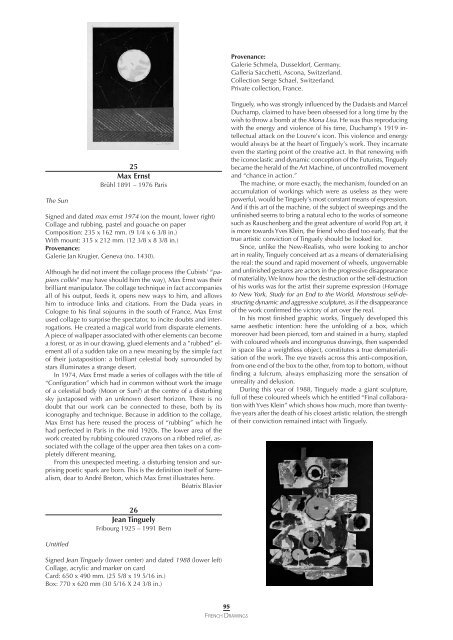Create successful ePaper yourself
Turn your PDF publications into a flip-book with our unique Google optimized e-Paper software.
Provenance:<br />
Galerie Schmela, Dusseldorf, Germany.<br />
Galleria Sacchetti, Ascona, Switzerland.<br />
Collection Serge Schael, Switzerland.<br />
Private collection, France.<br />
The Sun<br />
25<br />
Max Ernst<br />
Brühl 1891 – 1976 Paris<br />
Signed and dated max ernst 1974 (on the mount, lower right)<br />
Collage and rubbing, pastel and gouache on paper<br />
Composition: 235 x 162 mm. (9 1/4 x 6 3/8 in.)<br />
With mount: 315 x 212 mm. (12 3/8 x 8 3/8 in.)<br />
Provenance:<br />
Galerie Jan Krugier, Geneva (no. 1430).<br />
Although he did not invent the collage process (the Cubists’ “papiers<br />
collés” may have should him the way), Max Ernst was their<br />
brilliant manipulator. The collage technique in fact accompanies<br />
all of his output, feeds it, opens new ways to him, and allows<br />
him to introduce links and citations. From the Dada years in<br />
Cologne to his final sojourns in the south of France, Max Ernst<br />
used collage to surprise the spectator, to incite doubts and interrogations.<br />
He created a magical world from disparate elements.<br />
A piece of wallpaper associated with other elements can become<br />
a forest, or as in our drawing, glued elements and a ”rubbed” element<br />
all of a sud<strong>de</strong>n take on a new meaning by the simple fact<br />
of their juxtaposition: a brilliant celestial body surroun<strong>de</strong>d by<br />
stars illuminates a strange <strong>de</strong>sert.<br />
In 1974, Max Ernst ma<strong>de</strong> a series of collages with the title of<br />
“Configuration” which had in common without work the image<br />
of a celestial body (Moon or Sun?) at the centre of a disturbing<br />
sky juxtaposed with an unknown <strong>de</strong>sert horizon. There is no<br />
doubt that our work can be connected to these, both by its<br />
iconography and technique. Because in addition to the collage,<br />
Max Ernst has here reused the process of “rubbing” which he<br />
had perfected in Paris in the mid 1920s. The lower area of the<br />
work created by rubbing coloured crayons on a ribbed relief, associated<br />
with the collage of the upper area then takes on a completely<br />
different meaning.<br />
From this unexpected meeting, a disturbing tension and surprising<br />
poetic spark are born. This is the <strong>de</strong>finition itself of Surrealism,<br />
<strong>de</strong>ar to André Breton, which Max Ernst illustrates here.<br />
Béatrix Blavier<br />
Tinguely, who was strongly influenced by the Dadaists and Marcel<br />
Duchamp, claimed to have been obsessed for a long time by the<br />
wish to throw a bomb at the Mona Lisa. He was thus reproducing<br />
with the energy and violence of his time, Duchamp’s 1919 intellectual<br />
attack on the Louvre’s icon. This violence and energy<br />
would always be at the heart of Tinguely’s work. They incarnate<br />
even the starting point of the creative act. In that renewing with<br />
the iconoclastic and dynamic conception of the Futurists, Tinguely<br />
became the herald of the Art Machine, of uncontrolled movement<br />
and “chance in action.”<br />
The machine, or more exactly, the mechanism, foun<strong>de</strong>d on an<br />
accumulation of workings which were as useless as they were<br />
powerful, would be Tinguely’s most constant means of expression.<br />
And if this art of the machine, of the subject of sweepings and the<br />
unfinished seems to bring a natural echo to the works of someone<br />
such as Rauschenberg and the great adventure of world Pop art, it<br />
is more towards Yves Klein, the friend who died too early, that the<br />
true artistic conviction of Tinguely should be looked for.<br />
Since, unlike the New-Realists, who were looking to anchor<br />
art in reality, Tinguely conceived art as a means of <strong>de</strong>materialising<br />
the real: the sound and rapid movement of wheels, ungovernable<br />
and unfinished gestures are actors in the progressive disappearance<br />
of materiality. We know how the <strong>de</strong>struction or the self-<strong>de</strong>struction<br />
of his works was for the artist their supreme expression (Homage<br />
to New York, Study for an End to the World, Monstrous self-<strong>de</strong>structing<br />
dynamic and aggressive sculpture), as if the disappearance<br />
of the work confirmed the victory of art over the real.<br />
In his most finished graphic works, Tinguely <strong>de</strong>veloped this<br />
same aesthetic intention: here the unfolding of a box, which<br />
moreover had been pierced, torn and stained in a hurry, stapled<br />
with coloured wheels and incongruous drawings, then suspen<strong>de</strong>d<br />
in space like a weightless object, constitutes a true <strong>de</strong>materialisation<br />
of the work. The eye travels across this anti-composition,<br />
from one end of the box to the other, from top to bottom, without<br />
finding a fulcrum, always emphasizing more the sensation of<br />
unreality and <strong>de</strong>lusion.<br />
During this year of 1988, Tinguely ma<strong>de</strong> a giant sculpture,<br />
full of these coloured wheels which he entitled “Final collaboration<br />
with Yves Klein” which shows how much, more than twentyfive<br />
years after the <strong>de</strong>ath of his closest artistic relation, the strength<br />
of their conviction remained intact with Tinguely.<br />
26<br />
Jean Tinguely<br />
Fribourg 1925 – 1991 Bern<br />
Untitled<br />
Signed Jean Tinguely (lower center) and dated 1988 (lower left)<br />
Collage, acrylic and marker on card<br />
Card: 650 x 490 mm. (25 5/8 x 19 5/16 in.)<br />
Box: 770 x 620 mm (30 5/16 X 24 3/8 in.)<br />
95<br />
FRENCH DRAWINGS
















